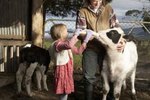If you're looking for a good family milk cow, the Jersey can fill the bill. This breed produces large quantities of quality milk, containing more protein, calcium and phosphorous than milk from other cows. Although the standard Jersey cow weighs between 800 and 1,200 pounds at maturity, there is also a miniature version suitable for smaller acreages.
Jersey Cow Adaptability
Jerseys tend to thrive no matter the type of farm management system. They adapt to living on pasture, in either a small or large herd, or in dry lots consuming hay. They do well in various climates, including tropical regions. That's about as far from their native Isle of Jersey in the Channel Islands as possible. Modern Jerseys are found worldwide.
Jersey Maturity
Jersey heifers experience their first heat cycle earlier than other bovines, when they are approximately 50 percent of their adult size. That's generally about the age of 13 months. The American Jersey Cattle Association reports that Jerseys have the earliest age for initial calving of all breeds. Jerseys are renowned for calving ease, and even heifers experience few problems giving birth. Early puberty, high fertility rates and ease of calving mean that Jersey cows can produce more offspring during their lifetimes than comparable dairy breeds.
Raising Calves
Traditionally, dairy calves are separated from their mothers soon after receiving colostrum -- the first milk full of antibodies -- and raised with other calves. They drink milk from buckets and eat grain early on, with hay added at about 3 months of age. Cornell University's Small Farms Program recommends another alternative for the small, organic farmer. The calf actually nurses from the mother until weaning, which eliminates feeding costs for the calf while still allowing the farmer to milk the cow daily, albeit at less output.
Since Jersey cows are such prolific producers, this is a suitable arrangement for the family farm, making less work for all involved while still providing sufficient amounts of milk for daily human needs. The calf ends up healthier as a result of nursing and growing up in a natural, less stressed environment.
Miniature Jerseys
The miniature Jersey results from crossing smaller Jerseys with other small-breed cattle, including the Galloway and Dexter. Only those animals consisting of 7/8 or more Jersey lineage are eligible for registration in the miniature Jersey herd book. These cows mature at 46 inches or under in height, weighing 700 pounds or less. Caring for miniature Jerseys is similar to that of the full-size breed, although the smaller cows do not require as much feed.
Writer Bio
Jane Meggitt has been a writer for more than 20 years. In addition to reporting for a major newspaper chain, she has been published in "Horse News," "Suburban Classic," "Hoof Beats," "Equine Journal" and other publications. She has a Bachelor of Arts in English from New York University and an Associate of Arts from the American Academy of Dramatics Arts, New York City.




